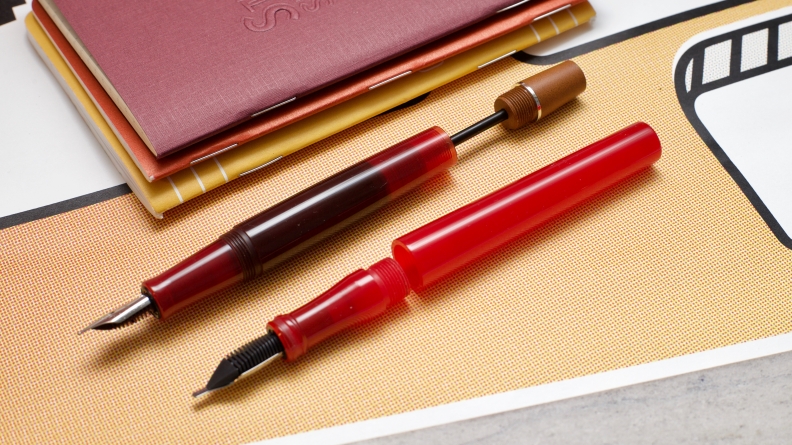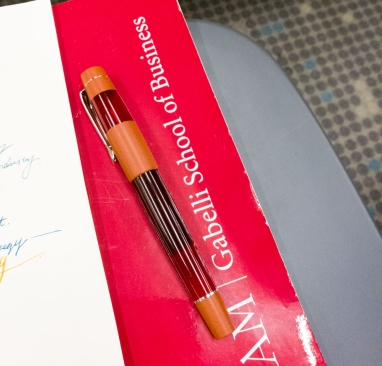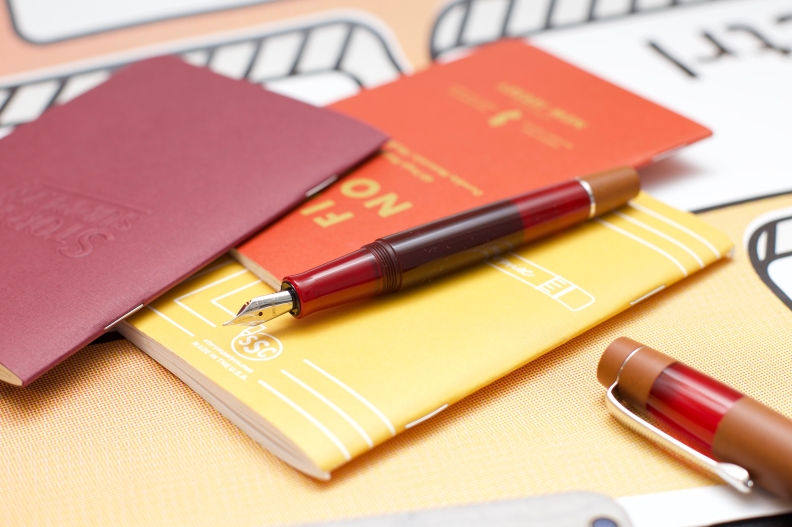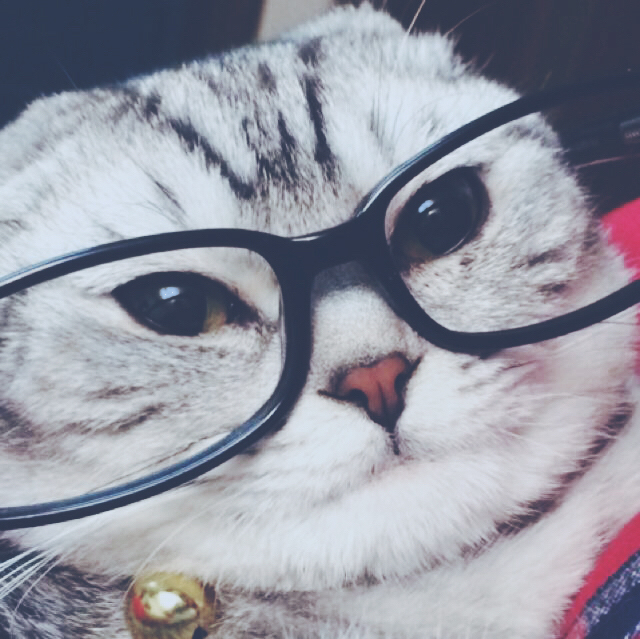How hard have I longed for a pen built out of ebonite? Every time during a pen show that I’ve come across a hard rubber pen from India or Pakistan, I was shocked by the sturdiness and warmth conveyed by this material. But the kicker there was always the designs of such modern ebonite pens: a chunky cigar shape eyedropper, always decorated under a ripple pattern. There is nothing wrong with those designs trying to be reminiscent of the pens in the 1920s, but I still prefer a vintage Waterman’s Ripple in the future. As for my love for this material, I have a Ripple pencil instead.

Thus, when the Opus 88 Koloro hit the PenChalet’s home page, I was instantly persuaded. With a balanced design that looks absolute modern, the Taiwanese pen maker sharing its extra caring by mixing the ebonite and acrylic together. Available in four eye-soothing color options, the Koloro is also eclipsing all other modern eyedropper fillers in the affordable range with a dedicated system that harness a shut-off valve operated from the tail. Internally, a branded German nib and feed add another stratum to its talents portfolio, making the whole package of texture, design, and engineering worth the efforts.

- Packaging of the Red Red

- From Top: Koloro, Model 03, M1000
The model I’m reviewing is priced at $93 for the U.S. market, and it is currently on sale with a 10 percent discount. It comes in color described by the PenChalet as Red Red, which is called in Taiwan by its maker as Cinnabar Red (丹). It is not impossible that their oversea distributor found the task of converting the subtlety behind the single Chinese character into the context of an English-speaking culture somehow difficult, and they opted for a straightforward naming strategy by calling the color of acrylic and ebonite altogether. Thus for the rest of the Koloro line, you have Blue Blue, Yellow Yellow, and Blue Tan, which is an extraordinary popular one that contributes the majority of the sales in states. They are all great palettes from a design perspective, and I can see the attraction in all of them.
The ebonite, (also hard rubber or Vulcanite) was once the primary material for fountain pen caps, barrels, sections, and even feeds before the introduction of plastic in the mid of 1920s. Nowadays, this material is usually used as the base material for the maki-e works in premium Japanese pens, and besides the brands above in Mid Asia, there are not too many options between. With that said, it is just plainly a surprise to find a brand is pushing this material back to the market on a scale much bigger than these Mid-Asian brands. Taiwanese fountain pen brands have been on my radar almost since the first day of my entering into the pen rabbit hole, but I am most familiar with brands like Telex, TWSBI, and Laban. But clearly, I missed something. The company behind the Koloro is Gin Ji Industrial Co., Ltd, and it has been making fountain pens and accessories under the name Opus 88 for over four decades. Base on their product page, it is clear they have a deep understanding of how to build high-end fountain pens with exotic base material such as ceramic, mother of pearl, horns and, guess what, ebonite and maki-e.

- The Detailed Instruction from Opus 88

- Small Pattern Setting on the Edge of the Clip
The Koloro doesn’t have maki-e artworks, but it does have three sections of legit ebonite in a matte finish, with the rest of the body built with semi-transparent acrylic parts. It is a bold and effective decision. There are no elements of nostalgia meant to be felt, and each of these two material harmoniously serves their own roles. The brutally clear-cut ebonite finials and cap band (a wide one!) have a harmless matte texture that resists fingerprints and other blemishes during everyday usage admirably well. The acrylic parts are glossy and crispy, showing off only the beauty of the nib even when the pen is capped. This idea of mixing material is certainly a genius one.

- Same Material, Different Style.
When compared with my tiny Waterman pocket pencil, the difference between the same material is easy to perceive. The Ripple has a paradigm so strong that I can hardly deny that my appreciation of this pattern has more to do with the stories and legacy around it rather than the material itself. But in the case of Kokoro’s ebonite, its natural pattern of subtle black dots really catches my eyes. The ebonite and acrylic are all precisely machined, and they work together smoothly. There is no stink from the material, too.
At 0.8 oz, the Koloro weighs almost the same as a Kaweco Classic Sport when not inked. Which is not to say that it is a feather light pen since the physical dimension of this pen is relatively big, which also leads to a substantial amount of filling capacity since it is an eyedropper filler.

The almost cliché idea of being an eyedropper—fill by removing the section and dropping the ink into the barrel—is present on the Koloro, with a unique twist. Here, Opus 88 is literally replicating what you are expected to find from flagship Japanese eyedroppers: an eyedropper-only barrel with a shut-off valve operated by the blind cap. It’s a delicate system. Unscrew the section, you would find a piston valve setting within the barrel, as well as a similar concavity with a crevice inside the nib section. The valve is attached to a long center rod that is also made from ebonite, and the section has a nice O-ring at the end of the thread. Detailed filling instruction has been described by the company in both Chinese and English, and put it simply, to fill this pen, you are supposed to fill the barrel using the nice eyedropper sent along with the pen until the visible internal threads, and then put the section back, no silicon grease is needed. To use the pen for the first time, unscrew the blind cap a little bit, and then you are good to go for pages. If you are going to have a flight or a fight with this pen in your bag, keep the blind cap shut off and you will have little or no leakage from the ink reservoir, like the way to use a Pilot 823.

I have many pens that have been turned into eyedropper fillers, but the Koloro is the only one that could only be used as an eyedropper. To make a comparison, I pulled out the currently un-inked Franklin-Christoph Model 03 Iterum, which is a great looking piece of acrylic work in a typical FC style. To fill this pen, like any other FC pens, I need to apply at least two layers of silicon grease, one for the sealing of the main barrel, and one for the sealing of the nib unit inside the section. Having tons of ink filled the barrel is certainly an enjoyment both to eyes and hand, but my mind must be on alert every time since, in the winter, the ink can blurt out from the feed if there are too many airs inside the barrel due to the warmth of my palm. To clean an eyedropper like this is also a nightmare, besides the ink stains inside the barrel, you still have to take extra care to the silicon which began to move everywhere once you fully disassemble the pen. All these mumbo-jumbo do not exist for an eyedropper filler with a shut-off valve, like my Koloro Red Red.

During the past week of using my Koloro, I can tell this shut-off valve really works like a charm. I am no longer feeling compulsory to run like a cameraman (steady…) if I want to catch my subway train if I carry this pen in my backpack, and I can always enjoy the satisfaction of having a whole barrel of ink swirling within my palm and caring nothing about the status of the feed.

- (The Feed was Colored by the Robert Oster Lake of Fire)


- Writing Sample
As for the nib, to be honest, I was uncertain in the first place about the size of its #5 nib. It is a size always feels too small for me after using the Live in You’s Mitu and Franklin-Christoph’s Model 45, but it turned out the design of the Koloro compensate the shortness of the nib. When posted, it has a balance which makes it feels not too different from a Model 03. It also features a nib section curved in a way like a Model 03, making the handling way better for my hand. The #5 nib and feed combo are probably from Bock, and they deserve a default appraisal, just like when you get a laptop with an 8th generation Intel chip.

The only one thing I miss from my Franklin-Christoph eyedroppers is their block thread, a design which allows those pens to be unscrewed in a blink. Opus 88’s choice of threads here is the other end of the scale: the Koloro takes almost eternity (four complete turns) to reveal the nib section. A design like this may lie in the physical properties of the ebonite, which is normally less durable than acrylic, so the company cut the threads shallower and longer. I give the company a note of understanding here if that is the truth. I want my ebonite pen to last, not break halfway while unscrewing the cap, and if I really have an urgent task of notetaking, I have my ballpoints.

According to the GM of the Opus 88, Mrs. Hsu, the Koloro series is one of the company’s first attempts to make a fountain pen with a more affordable price tag and good for day-to-day writing. After my experience with the Koloro, her expectation has been achieved. Though some may argue the price range is somehow too steep for a new model with a small nib, to pick a pen with similar features is a hard task. For me, the delights of the Koloro’s modern ebonite design and the absolute peace of mind that comes with its shut-off valve are an unbeatable value proposition. Days ago, the company announced that it has managed to set up its distribution network across the Asia, Europe, and United States; maybe it is the time to study the holiday discount tricks and plan for a steal of your Koloro!




























So the Koloro doesn’t burp ink when the ink level gets too low? That’s really cool. Is it because of the shut-off valve?
I love the image of you running like a cameraman to avoid shaking up your pens. 🙂 Great review!
LikeLiked by 1 person
Thanks for this info! I’ve been interesting in purchasing one of these but I wanted to hear more about them. You’ve convinced me it’s a worthwhile purchase.
LikeLiked by 1 person
Glad that you made it here to get some information you need! Wish you get the pen before the Christmas and enjoy it. BTW, which color is your favorite?
LikeLike
Great review, Frank Underwater. I found your blog via The Well-Appointed Desk. I am thinking about getting the red one–it’s such an interesting pen.
LikeLiked by 1 person
Wow, I am honored to be named by Ana! And thank you Denise for informing about this, happy holidays and may you enjoy your Opus 88 as well.
LikeLike
This is a great review and super awesome photos! I have had my Opus 88for a few weeks now and I am completely enjoying it. I too always wanted an ebonite pen. This pen is well done.
LikeLiked by 1 person
Oh thanks Cassie! I picked up a poster I got from The Verge that day for a vivid background.
After the following weeks I have found the smaller form factor of the #5 is working like a charm with the overall design, can’t agree with you more that it is well done!
LikeLike